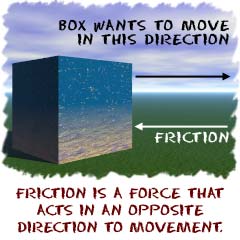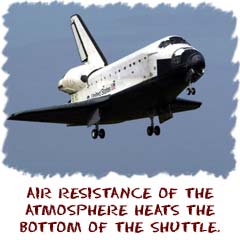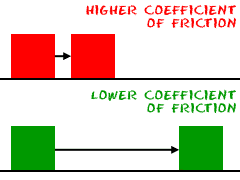Friction Basics
 Friction is a force that holds back the movement of a sliding object. That's it. Friction is just that simple.
Friction is a force that holds back the movement of a sliding object. That's it. Friction is just that simple.
You will find friction everywhere that objects come into contact with each other. The force acts in the opposite direction to the way an object wants to slide. If a car needs to stop at a stop sign, it slows because of the friction between the brakes and the wheels. If you run down the sidewalk and stop quickly, you can stop because of the friction between your shoes and the cement.
What happens if you run down the sidewalk and you try to stop on a puddle? Friction is still there, but the liquid makes the surfaces smoother and the friction a lot less. Less friction means it is harder to stop. The low friction thing happens to cars when it rains. That's why there are often so many accidents. Even though the friction of the brakes is still there, the brakes may be wet, and the wheels are not in as much contact with the ground. Cars hydroplane when they go too fast on puddles of water.
Friction and Gases
 Friction only happens with solid objects, but you do get resistance
to motion in both liquids and gases. This doesn't involve sliding
surfaces like friction does, but is instead the kind of resistance you
get if you try to push your way through a crowd. It's a colliding
situation, not a sliding one. If the gas is air, this is referred to as air resistance.
Friction only happens with solid objects, but you do get resistance
to motion in both liquids and gases. This doesn't involve sliding
surfaces like friction does, but is instead the kind of resistance you
get if you try to push your way through a crowd. It's a colliding
situation, not a sliding one. If the gas is air, this is referred to as air resistance.
If you were in the space shuttle and re-entering the atmosphere, the bottom of the shuttle would be getting very hot. The collisions that occur between the molecules of the air being compressed by the shuttle, heat up the air AND the shuttle itself. The temperature on the top of the shuttle is also warm, but nowhere near the temperatures found on the bottom.
Friction and Liquids
Although liquids offer resistance to objects moving through them, they also smooth surfaces and reduce friction. Liquids tend to get thinner (less viscous) as they are heated. Yes, that's like the viscosity of the oil you put in your car. Car engines have a lot of moving parts, and they rub on each other. The rubbing produces friction and the result is heat. When oil is added to a car engine, the oil sticks to surfaces, and helps to decrease the amount of friction and wear on the parts of the engine. An engine that runs hotter requires a more viscous oil in order for it to stick to the surfaces properly.Measuring Friction
 Measures of friction are based on the type of materials that are in contact. Concrete on concrete has a very high coefficient of friction.
That coefficient is a measure of how easily one object moves in
relationship to another. When you have a high coefficient of friction,
you have a lot of friction between the materials. Concrete on concrete
has a very high coefficient, and Teflon on most things has a very low
coefficient. Teflon is used on surfaces where we don't want things to stick; such as pots and pans.
Measures of friction are based on the type of materials that are in contact. Concrete on concrete has a very high coefficient of friction.
That coefficient is a measure of how easily one object moves in
relationship to another. When you have a high coefficient of friction,
you have a lot of friction between the materials. Concrete on concrete
has a very high coefficient, and Teflon on most things has a very low
coefficient. Teflon is used on surfaces where we don't want things to stick; such as pots and pans.
Scientists have discovered that there is even less friction in your joints than in Teflon! It is one more example at how efficient living organisms can be.
Friction
- Friction is a force opposing the movement of one surface over another.
- The Magnitude of the Force of Friction depends on the following factors:
- The roughness of the surfaces (e.g. stepping on banana peel compared with carpet)
- The force pushing the surfaces together (e.g. A heavy truck's tires compared with a bicycle's tires on the road)
- Whether the surfaces are moving or stopped
- 3 Types of Friction
- Static Friction - acting between 2 stationary bodies (e.g. holding a person on a chair)
- Sliding Friction - acting between surfaces where one is moving (e.g. sliding furniture across the floor, writing with a pencil on paper)
- Rolling Friction - acting between surfaces of objects where one has a rounded shape (e.g. car tyres on the road, ball bearings); less than sliding friction
- 4 Ways to Reduce Friction
- Reducing the force pushing both surfaces together
- Using a lubricant such as oil or water between the surfaces
- Using ball bearings or rollers between both surfaces
- Polishing both surfaces